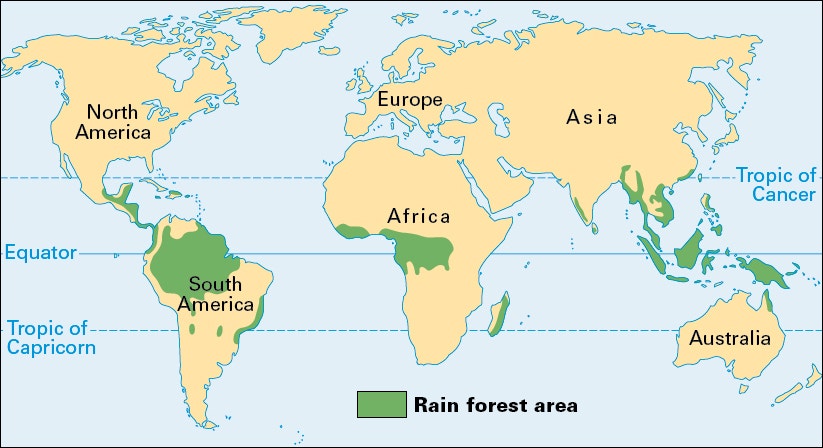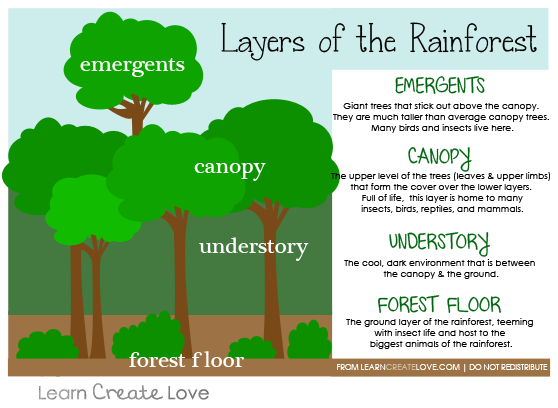Rainforest layers
The tree tops in a tropical rainforest fit together almost like puzzle pieces. They can form an unbroken cover called the canopy high above the forest floor. A few giant trees or emergents may rise above the canopy.
Palm trees, vines and epiphytes (air plant) may form a lower level of treetops called the sub-canopy. Underneath this is the understory. Little light reaches the understory. Plants need light to make food. Shrubs, fungi and other small plants compete for light in the understory and on the forest floor.
Source: World Book Kids, 2017
Tropical rainforests

A rainforest is a woodland with tall trees and plenty of rainfall. Many rainforests grow in tropical areas. Tropical rainforests are usually rainy the year around. They are also quite warm. The warmth and moisture are ideal for plant growth. The trees often grow to great heights. Rainforests are also home to many other kinds of plants.
There are tropical rainforests in Africa, Australia, Central America, South America, Southern Asia, and the South Pacific islands. A few rainforests are found away from the tropics in cooler temperate regions. These are called temperate rainforests.

How important is the rainforest?
The rainforest is a type of ecosystem. An ecosystem is a community of living things that are connected and rely on one another and on their surroundings to meet their needs. Rainforests are some of the richest ecosystems on Earth. No other type of ecosystem supports as many different kinds of living thing.
Many products useful to people come from rainforests. Bananas, chili peppers, mangoes, pineapples, and many kinds of nuts come from rain forests. Cacao is the plant that gives us chocolate. It grows in the rainforest understory. Many medicines are also made from rainforest products. And there are probably many more medicines to be discovered.
Many native people live in the rainforest. They make their living by hunting, fishing, collecting forest products, and farming.
Source: World Book Kids, 2017
Find a Book . . .
Living and Non-living in the Rainforest by
Call Number: 577.34 RISISBN: 9781406265903Publication Date: 2014Rainforest by
Call Number: 577.34 GREISBN: 9780751332292Rainforest by
Call Number: 577.34 ARLISBN: 9781407136578The Rainforest by
Call Number: 577.34 MACISBN: 9780140378559Rainforest by
Call Number: EN 577.34 WILISBN: 9780753406786The Rain Forest by
Call Number: EN 591.734 BAKISBN: 9780750024921

WASLA Teacher Librarian of the Year- 2017: Jo-Anne Urquhart
- 2016: Lise Legg
WASLA Library Officer of the Year- 2012: Karen Notley